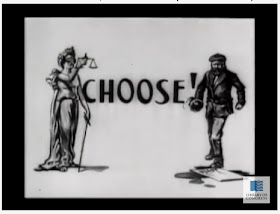
One hundred years ago, on July 22, 1916, the San Francisco plutocrats of the day sought to convince a skeptical working class in our city that ramping up armament production in preparation to join the raging European war would be a glorious enterprise. They staged a great civic parade down Market Street.
Someone disagreed, setting off a pipe bomb in the crowd, killing 10 people, injuring 40. Naturally the city fathers blamed anarchists and union leaders. Thomas Mooney and Warren K Billings were labor agitators with a history of knowing how to use dynamite. They were convicted of the crime despite no evidence of guilt. Radical campaigners struggled for decades to save them; they were not released and pardoned until 1939.
Walter Thompson has assembled the story at Hoodline.
After the bombing, Hearst-Pathé newsreel producers made a propaganda film about the events, pitting "anarchism" -- the era's label for terrorism -- against "liberty."In the summer of 1916, European powers were waging war in trenches and on the seas of the North Atlantic, but America remained neutral. Focused on pushing his New Freedom platform of progressive reforms, President Woodrow Wilson recognized that a war would hijack his ambitious social agenda.
Wilson ran for re-election on the slogan "He Kept Us Out of War," and Americans whistled along with a pop song called "I Didn't Raise My Boy to Be a Soldier." But there was a rising call for the U.S. to begin marshaling wartime resources. ...
By May 1916, New York and Chicago had rallied their citizenry to support a wartime build-up via preparedness parades. San Francisco's procession was organized by the Chamber of Commerce and other business interests, but there was still a strong isolationist streak. On the eve of the parade, mainstream and radical union leaders met at Dreamland Rink, a roller-skating palace at Post and Steiner, to denounce the celebration.
"The viewpoint of all those who spoke was that the preparedness propaganda is being carried out for ulterior purposes, and that it makes for a serious menace to the ideals of world peace," reported the San Francisco Chronicle. "Those present were advised to stand silent as the paraders passed." ...
The film remains fascinating. I particularly enjoy the upper class marching ladies in their "liberty" finery. I would recommend running the video at full screen at double-time for the best effect. This having been the silent film era, there is no sound; the movie theater pianist would have provided accompaniment.
No comments:
Post a Comment